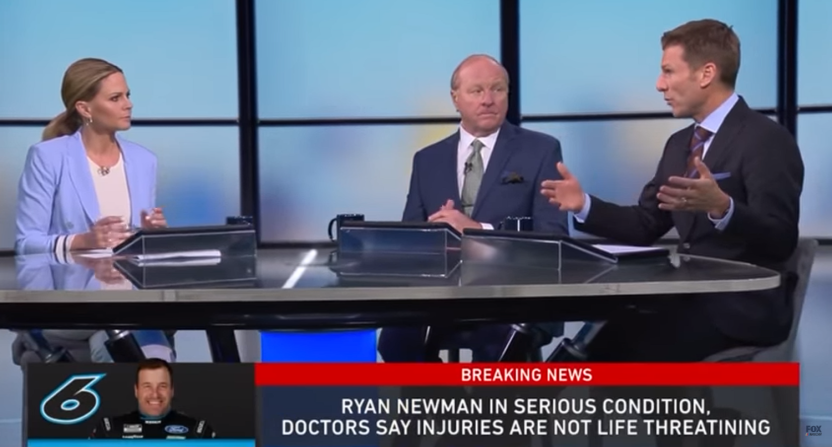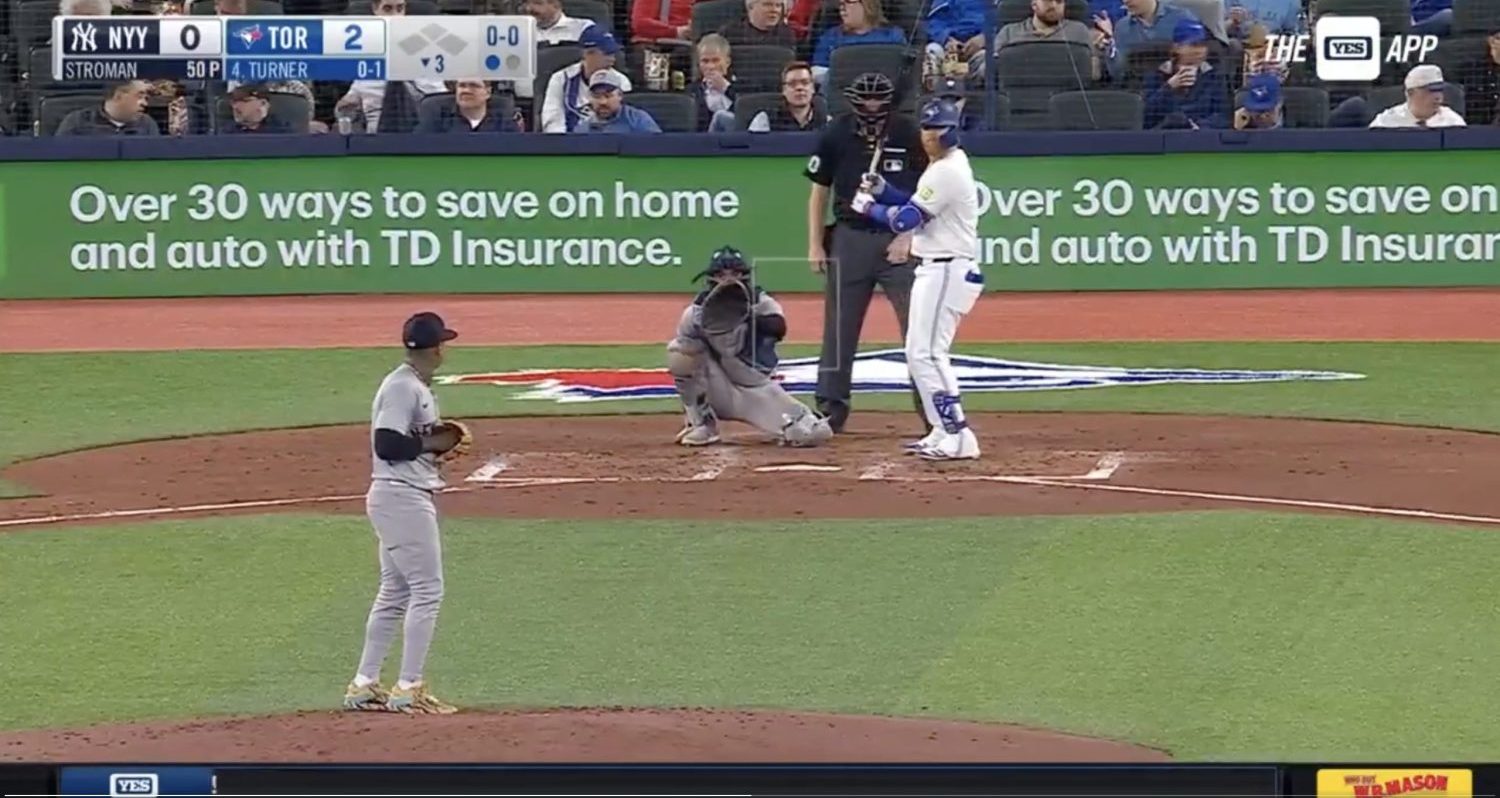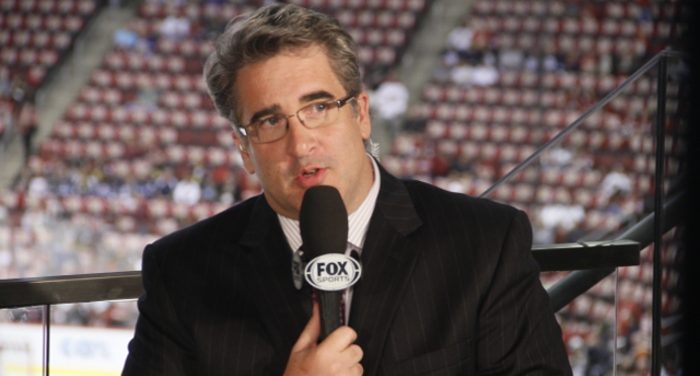Ahead of the 20th Daytona 500 on Fox Sunday (1:30 p.m. ET), AA spoke to several members of the NASCAR on Fox team. Our first piece from that, on the evolution of the network’s studio coverage, can be found here. Another element that came to mind, especially with the recent Damar Hamlin injury in the NFL and discussion of ESPN’s coverage of that, was how Fox covered Ryan Newman’s terrifying crash in the 2020 Daytona 500 and his subsequent hospitalization.
Newman himself spoke to AA’s Phillip Bupp on that crash in 2021. Ahead of this year’s Daytona 500, NASCAR on Fox play-by-play voice Mike Joy, race analyst/post-race analyst Larry McReynolds, post-race (NASCAR Race Day) host Shannon Spake, and post-race analyst Jamie McMurray (all role titles reflecting what they were doing then: Spake, McReynolds, and McMurray are seen left to right above on the post-race show discussing the crash) all spoke to AA about what happened in 2020 and how they covered it. Joy said the critical first thought was to transition from a sports model to a news model.
“When you have something of that magnitude, as our long-time producer Barry Landis has always told us, ‘This stops being a sports telecast and becomes a breaking news story,” Joy said. “From that moment on, you are working for that athlete’s family. And you’re no longer telling the tale of the race, because the race suddenly is not that important, you’re working on that news story.”
Joy has called races with many other terrifying crashes over the years, including Dale Earnhardt’s fatal crash at the 2001 Daytona 500 (which Joy, McReynolds, Matt Yocum, and Chris Myers all spoke to AA on in 2020.) He said the Fox team has learned from covering these crashes that the broadcast team has to provide much of their own information early on.
“The other thing we have learned over the years, and especially from those two incidents [Newman and Earnhardt], is that you’re doing it in a vacuum. There is not going to be information from the scene from the control tower, there are not going to be updates from the sanctioning body. You are dependent on what you observe, what you know, and that’s pretty much it. But you have to carry the day.”
“So you look at things like the apparent severity of the crash, you look at the response team and how they are responding; is it in kind of a controlled, unrushed way, is the activity at the scene frantic? And you look at what views you have available, some of which may be shown at home and some of which may not, and you try to put together the story as best as you can. And one of the first things you have to do is take a look at everything you’ve observed and come up with parameters.”

Joy said it’s important to consider what the outcomes could be, and to make sure that the tone of on-air discussion reflects that without going into speculation.
“You have to set parameters of ‘What is likely to have happened here? What is the best-case outcome? What is the worst-case outcome?’ And you try to find something that doesn’t exceed either one of those. And you have to come up with words that explore those possibilities without guessing or speculating. You can’t be way, way positive, because you don’t know if the driver’s hurt. You can’t be way, way, somber, because you don’t know if he’s hurt, how badly he’s hurt.”
He said he was impressed with ESPN’s coverage of the Hamlin situation.
“It’s a very difficult, and a very thin, tightrope that we walk in those situations, just as happened in the NFL,” Joy said. “I think that group did the very best they could given the scant amount of information they had, and maybe some of the conflicting reactions from people down on the field. It’s the toughest thing you do in sports broadcasting, having to turn that corner from broadcasting a sports event to being at the center of a news story like that.”
McReynolds said the Hamlin situation also made him think of the Newman one, including with the post-race coverage he did with Spake and McMurray.
“It was very difficult. We were absolutely flying by the seat of our pants,” he said. “And sitting here at my house and watching the Buffalo Bills and the Cincinnati Bengals and what ESPN was going through, it actually made me reflect back on that a lot. And it made me proud of what Shannon and Jamie McMurray and myself actually did.”
“As Mike Joy has always said, ‘When you’re put in those situations, you are working for one group of people and one group of people only, and that’s the family and friends of the victim. You can’t speculate, you can’t guess, you can only give facts. It’s no different than ESPN [with Hamlin], we had very little information, and we were tap-dancing our guts out, but trying to just make sure…you had to think about every word before you said it, because one word could take this thing the wrong direction.”
“I watched what ESPN had to deal with, with Suzy Kolber and that group in the studio and Joe Buck and Troy Aikman and that group at the actual stadium, and I felt for them, because I remembered being there. And I remembered being there in 2001 as well with Dale Earnhardt. But fortunately, we had Mike Joy guiding our ship. And that’s what Darrell Waltrip and I needed [on the race in 2001], because we were true rookies. But it made me proud of how Shannon and Jamie and I handled that 30 or 40 minutes that we were tap-dancing [on post-race coverage].”
McMurray said the Hamlin situation brought thoughts of Newman coverage to mind for him as well.
“It’s so relatable right now because of what happened with Damar Hamlin. I watched that live, and I kind of focused on Joe Buck and Troy Aikman, and how do you react to that? Because it was a similar situation.”
He said there’s so much temptation to speculate, especially when you’re stuck on-air without information, but Fox’s producers helped them avoid that pitfall.
“I think what’s really hard for the viewer to understand is that the worst thing you can do when you are in that position is give an opinion or speculate. Because really, your pure hope is to say ‘I think they’re okay,’ but you can’t do that. And fortunately, you have producers in your ear over and over again saying ‘Do not speculate, stick to the facts.'”
McMurray said it was also difficult to be patient, but knowing that they would ultimately get the information was helpful.
“No one was going to know quicker than we were, and we were going to provide that information to the viewer as quick as we could,” he said. “But first we had to make sure that we had our facts straight, to wait until we got the information. It’s not the time to give an opinion.”
He said one area he did feel he could speak to was what the experience was like from a driver’s perspective.
“Being an athlete, there was a question of ‘What are the other drivers thinking?’ And that I could speak to. But you don’t want to take a guess on being medically wrong.”
McMurray has seen plenty of crashes over his years as a driver and broadcaster, but said he generally felt safe in NASCAR.
“I would say that most drivers feel the same way and feel safe in the car. There are rare instances where someone does get hurt. And maybe it’s a little bit different this year, from last year, with all the crashes that we had. What’s so weird about that is that it wasn’t the huge wrecks you’d expect that to come from, it was smaller hits.”
“But for most of my career, I always felt really safe in the car. Certainly at Daytona and Talladega, when I flipped, you don’t know what’s going to happen: ‘Is there a fire, can I get out, am I trapped?’ There’s a lot of stuff that runs through your head quickly. But I would say that 99 percent of the time you feel that when you do get into an accident, it’s going to be okay. Maybe that’s naïve optimism to feel that way, but for the most part, I feel that the cars are pretty safe and that something bad doesn’t happen.”
For Spake, she said something that really stood out in her mind was the interview she did with Newman in August 2020 ahead of his return to Daytona for a race.
“I was able to sit down with Ryan when he was going back to Daytona, I got to do an interview with him, and I really wanted to do that interview with him, because I wanted to share with him—and I’m friends with him, and had texted with him and that, but I had never shared with him the events of that evening.”
Spake said the Newman situation had profound impacts on everyone involved in covering it.
“What’s so moving, or fascinating, and I felt like I got this from him when I told him this story, is that this was an event that happened to him, but it happened to so many different people in so many different ways. So many people lived that event in a different way. And before I started that interview with him, I told him that I was so proud of our crew that night. We were watching a lot of camera views, where they were taking him out of the car, and the views told a tough scene. And we really did not know what was going to happen.”
The latest
“So they take him to the hospital, and immediately, as a group…we sit down and we start to block the steps of what we’re going to do depending on various outcomes. We knew eventually that NASCAR was going to make a statement, we didn’t know what time they were going to make a statement, and we didn’t know what that statement was going to be.”
“We had two different ways that we were going to go, obviously if he had survived and if he hadn’t survived. So I had two different pieces of paper with questions on them. And on one, it said ‘Alive,’ and on the other, it said nothing. So when they came to us live on air and I had to throw to [NASCAR COO] Steve O’Donnell out at Daytona, again, we had no what Steve O’Donnell was going to say in this press conference.”
Spake said not knowing that outcome in advance was helpful in one way.
“They did not tell us ‘Hey, he’s alive, we’re good.’ We had no clue. And on the one hand, you go ‘I wish I would have known,’ but on the other hand, if I had known and it hadn’t been positive, I don’t know how I would have done it. I think it would have been a lot harder for me to get through it, because I know Ryan, and I’ve known Ryan for many years, and like most of the drivers in this sport, you feel like they’re family. You feel like you live with these people 10 months out of the year every single day.”
“So when we threw to Steve O’Donnell and he said Ryan had survived, I immediately threw the piece of paper that had all the questions about him not making it on the ground. People wish I would have kept that, I just threw it on the ground. And we started to move forward with the conversation that we had planned if he had survived the wreck.”
But even after that press conference, there was still a lot of uncertainty.
“We still had no idea what was going to happen,” Spake said. “We knew he had survived the crash, but we had no idea how bad it was. People were texting, there were all these reports coming in, there were people on Twitter, it was all this crazy stuff that you’re trying to sift through. …We went back the next day, because we had Race Hub the next day, and we still didn’t really know what was going on, and obviously the reports began to come out.”
Spake said the impacts of the incident, and what might come next, sat with her long after the initial broadcast.
“I went home that night, and it was probably 3 o’clock in the morning by the time I got home, and I remember sitting in my kitchen just staring at the wall,” she said. “It’s someone that you know. And you had to just go on air and talk about it and have a conversation about somebody that you know who just went through this horrific wreck. And you know that [Ryan’s wife] Krissie is on the way with the girls, and I know Krissie, and I know the girls.”
She said she was impressed with what the Fox team was able to do around such a tough situation, though.
“I was really proud of the way that we all came together as a group and prepared as a group and really kind of put a lot of thought and a lot of care and a lot of love and energy into how we were going to handle that situation.”







